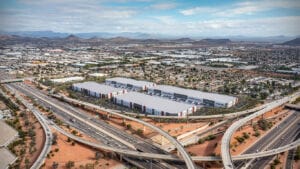Like every industry, commercial real estate is affected by legislation and rulemaking processes throughout all levels of government. Suzanne Kinney, president and CEO of NAIOP Arizona, notes that political environment in Arizona has changed dramatically over the past several years.
MORE NEWS: NAIOP members detail trends to watch in commercial real estate
“We are truly a swing state, which is new and different,” she says. “It’s a polarized time, nationally all the way down to the state level, and there are extremes on both sides of the political spectrum. That creates a new set of challenges when we’re dealing with elected officials to get the work of the people accomplished.”
NAIOP has always been engaged in public policy — Kinney highlights the association’s efforts to reduce property tax rates that affected the competitiveness of the state. That initiative, she continues, was narrowly focused but the issues facing the industry, such as water supplies, energy and air quality, necessitate more resources to tackle. Just this last year the association brought on John Baumer as its director of government relations.
“In the changing political environment, especially at the state level, we found it was necessary to have that full-time presence representing NAIOP and our members at the state capitol,” Kinney says. “There are big, overarching issues that are not going to have a single, simple policy solution to them where one bill solves the challenge. These are going to be issues that require a lot of legislation over a period of many years to rise to the challenges that are in front of us.”
Water and air
Water issues have long been a top priority in Arizona, with the Groundwater Management Act of 1980 serving as a landmark piece of legislation addressing water supplies. As the Colorado River suffers from drought conditions, concern over the state’s water future has become more acute.
Baumer says having NAIOP at the table during these discussions is needed to advocate on behalf of commercial real estate.
“When it comes to water management, stewardship and conservation, there are misconceptions out there as to what commercial development uses for water on average,” he continues. “It’s been an education campaign this past year for lawmakers and other stakeholders. We want to make sure we’re part of the conversation so any improvements to how we oversee water in the state are smart, intentional and economical.”
Another area that warrants attention is air quality and how that may impact future developments. This issue, Baumer explains, is complicated because it involves the EPA and the Clean Air Act, which are policy areas that can’t be easily changed.
“When it comes to manufacturing development, we don’t have the same ability as other states to offset the emissions, so we’re going to hit a point in the near future where we will not be able to develop those manufacturing projects,” he says. “That’s going to have a real impact. Arizona doesn’t have tons of coal stacks that can be turned offline to improve air quality and receive offsets — we’re tapped out when it comes to that.”
NAIOP is working with state representatives, congressional delegation and other groups to tackle the issue. Baumer is hopeful that coordination with other impacted states can help address the problem and find solutions to sustain Arizona’s growth.
Housing affordability
Kinney adds that as Greater Phoenix has grown rapidly into an emerging Tier 1 city new problems have emerged. One of the attractive aspects of the region to out-of-state businesses was the availability of affordable housing for their workforces, but that has changed in recent years. That, along with NAIOP starting to include more members in the multifamily sector, means the association is now more involved with housing issues.
“Housing and permitting reform are things that we don’t believe the solutions are going to come from the state legislature,” Baumer says. “Part of our strategic plan is to build stronger relationships with localities — mayors, council members and planning departments to figure out where things can be improved. There are things that can be done in the private sector to make [the process] easier for local governments, but we need to have a frank conversation about how to best go through the city process from buying a piece of land to actually getting something built.”
One of the points Baumer says is important for municipalities to understand is that the more amenities they require a multifamily development to have, the less affordable those units will be for renters.
“We need to figure out a path forward that lets localities keep their individual jurisdictions as they want, but also meet the needs of Arizona residents,” he says.
A popular idea to address the housing shortage has been turning unused commercial space into apartment units. The process, Baumer says, isn’t a simple one.
“There’s talk about how we can better utilize unused office or retail space. I’ve had conversations with lawmakers and stakeholders that think you can turn a strip mall into housing, but it’s not that easy,” he continues. “For us, it’ll be having conversations about where the tolerances are for incentives are for these adpative reuse and conversion projects, because that’s huge. Without incentivizing it or offering something like tax breaks, it’s still going to be difficult for these conversions to pencil out.”
Speaking to NAIOP members who have done these types of projects, Baumer says that the construction itself is difficult. When something is built for retail or office, the structure is considerably different from a building developed specifically for housing.
“Oftentimes in a commercial building, the utilities are all in the center of the building and feed out into the different offices,” he continues. “They have huge footprints, but not a lot of window space. It’s trying to figure out how to make those things work. And oftentimes, when developers go to convert a building, and you start tearing things apart — you never know what you’re going to find and what needs to be redone to get it up to code.”
Another housing issue of interest to NAIOP members relates to condos. Baumer notes that condo construction has been low since it’s hard for these projects to pencil out and developers can be faced with high insurance costs in some instances.
“There are also strict contracts written out that apartment units can’t be turned into a condo,” he continues. “There’s a desire not only from NAIOP but a number of other stakeholders to find out how to improve the market to make it so condos can actually be developed again and make that product type available to Arizona residents. It would take time for legislation to ripple out, but in the long run it would be beneficial to Arizona’s overall housing supply.”


